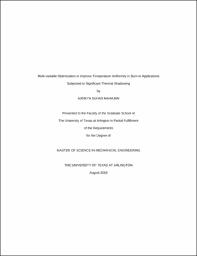
ATTENTION: The works hosted here are being migrated to a new repository that will consolidate resources, improve discoverability, and better show UTA's research impact on the global community. We will update authors as the migration progresses. Please see MavMatrix for more information.
Show simple item record
| dc.contributor.advisor | Agonafer, Dereje | |
| dc.creator | Mahajan, Ajinkya Suhas | |
| dc.date.accessioned | 2019-08-27T18:32:49Z | |
| dc.date.available | 2019-08-27T18:32:49Z | |
| dc.date.created | 2019-08 | |
| dc.date.issued | 2019-08-08 | |
| dc.date.submitted | August 2019 | |
| dc.identifier.uri | http://hdl.handle.net/10106/28597 | |
| dc.description.abstract | Burn-in test typically employs voltage and/or temperature to accelerate the appearance of latent reliability defects in semiconductor devices. As a result, burn-in becomes a critical step in the parts screening process and is the primary technique to eliminate defective parts in the early phase of the product life. Thermal control in burn-in processes is generally achieved by either active or passive thermal controlling. In an active thermal control, each device has an individual temperature monitoring system to maintain a specific temperature in which the cooling/heating of each socket is controlled by an individual fan or heater. Whereas in passive thermal control, a single fan provides convective heat transfer to an array of devices. Recent research regarding burn-in process suggests that passively controlled sockets are impacted more by temperature and airflow variation in burn-in ovens when compared to actively controlled sockets.
In our study, a fan and two sockets were placed linearly and the airflow characteristics were examined past the first-row socket. An air deflector was designed on the ceiling of the oven between the two sockets and was optimized for its location, size, and orientation to improve the heat transfer characteristic of the second-row socket.For analysis and optimization, socket and burn-in chamber design specification were obtained from Plastronics Inc. 3D CAD model was designed in Solidworks and was solved numerically considering appropriate boundary conditions in Solidworks native Flow Simulation. Finally, Multi-variable design optimization and response surface methodology were performed to propose an optimum design for air deflector to increase the thermal performance of socket in the burn-n application. | |
| dc.format.mimetype | application/pdf | |
| dc.language.iso | en_US | |
| dc.subject | Burn-in application | |
| dc.subject | Semiconductors | |
| dc.title | Multi-variable Optimization to Improve Temperature Uniformity in Burn-in Applications Subjected to Significant Thermal Shadowing | |
| dc.type | Thesis | |
| dc.degree.department | Mechanical and Aerospace Engineering | |
| dc.degree.name | Master of Science in Mechanical Engineering | |
| dc.date.updated | 2019-08-27T18:32:50Z | |
| thesis.degree.department | Mechanical and Aerospace Engineering | |
| thesis.degree.grantor | The University of Texas at Arlington | |
| thesis.degree.level | Masters | |
| thesis.degree.name | Master of Science in Mechanical Engineering | |
| dc.type.material | text | |
Files in this item
- Name:
- MAHAJAN-THESIS-2019.pdf
- Size:
- 1.830Mb
- Format:
- PDF
This item appears in the following Collection(s)
Show simple item record


